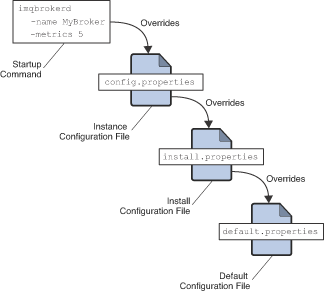IMQ_VARHOME/instances/instanceName/props/config.properties4 Configuring a Broker
A broker’s configuration is governed by a set of configuration files and
by the options passed to the imqbrokerd command at startup. This
chapter describes the available configuration properties and how to use
them to configure a broker.
The chapter contains the following sections:
For full reference information about broker configuration properties, see Broker Properties Reference.
Broker Services
Broker configuration properties are logically divided into categories that depend on the services or broker components they affect:
-
Connection services manage the physical connections between a broker and its clients that provide transport for incoming and outgoing messages. For a discussion of properties associated with connection services, see Configuring Connection Services.
-
Message delivery services route and deliver JMS payload messages, as well as control messages used by the message service to support reliable delivery. For a discussion of properties associated with message delivery services, including physical destinations, see Managing Message Delivery.
-
Persistence services manage the writing and retrieval of data, such as messages and state information, to and from persistent storage. For a discussion of properties associated with persistence services, see Configuring Persistence Services.
-
Security services authenticate users connecting to the broker and authorize their actions. For a discussion of properties associated with authentication and authorization services, as well as encryption configuration, see Configuring and Managing Security Services.
-
Clustering services support the grouping of brokers into a cluster to achieve scalability and availability. For a discussion of properties associated with broker clusters, see Configuring and Managing Broker Clusters.
-
Monitoring services generate metric and diagnostic information about the broker’s performance. For a discussion of properties associated with monitoring and managing a broker, see Monitoring Broker Operations.
Setting Broker Configuration Properties
You can specify a broker’s configuration properties in either of two ways:
-
Edit the broker’s configuration file.
-
Supply the property values directly from the command line.
The following sections describe these two methods of configuring a broker.
Modifying Configuration Files
Broker configuration files contain property settings for configuring a broker. Message Queue maintains the following broker configuration files:
-
A default configuration file (
IMQ_HOME/lib/props/broker/default.properties) that is loaded on startup. This file is not editable, but you can read it to determine default settings and find the exact names of properties you want to change. -
An installation configuration file (
IMQ_HOME/lib/props/broker/install.properties) containing any properties specified when Message Queue was installed. This file cannot be edited after installation. -
A separate instance configuration file (
IMQ_VARHOME/instances/`instanceName/props/config.properties`) for each individual broker instance.
In addition, if you connect broker instances in a cluster, you may need
to use a cluster configuration file (cluster.properties) to specify
configuration information for the cluster; see
Cluster Configuration Properties for
more information.
Also, Message Queue makes use of en environment configuration file,
imqenv.conf, which is used to provide the locations of external files
needed by Message Queue, such as the default Java SE location and the
locations of database drivers, JAAS login modules, and so forth.
At startup, the broker merges property values from the various
configuration files. As shown in Figure 4-1, the files form
a hierarchy in which values specified in the instance configuration file
override those in the installation configuration file, which in turn
override those in the default configuration file. At the top of the
hierarchy, you can manually override any property values specified in
the configuration files by using command line options to the
imqbrokerd command.

The first time you run a broker, an instance configuration file is
created containing configuration properties for that particular broker
instance. The instance configuration file is named config.properties
and is located in a directory identified by the name of the broker
instance to which it belongs:
If the file does not yet exist, you must use the -name option when
starting the broker (see Broker
Utility) to specify an instance name that Message Queue can use to
create the file.
|
Note
|
The |
The instance configuration file is maintained by the broker instance and is modified when you make configuration changes using Message Queue administration utilities. You can also edit an instance configuration file by hand. To do so, you must be the owner of the `instances/`instanceName directory or log in as the root user to change the directory’s access privileges.
The broker reads its instance configuration file only at startup. To
effect any changes to the broker’s configuration, you must shut down the
broker and then restart it. Property definitions in the
config.properties file (or any configuration file) use the following
syntax:
propertyName=value [ [,value1] … ]For example, the following entry specifies that the broker will hold up to 50,000 messages in memory and persistent storage before rejecting additional messages:
imq.system.max_count=50000The following entry specifies that a new log file will be created once a day (every 86,400 seconds):
imq.log.file.rolloversecs=86400See Broker Services and Broker Properties Reference for information on the available broker configuration properties and their default values.
Setting Configuration Properties from the Command Line
You can enter broker configuration properties from the command line when you start a broker, or afterward.
At startup time, you use the Broker utility (imqbrokerd) to start a
broker instance. Using the command’s -D option, you can specify any
broker configuration property and its value; see
Starting Brokers and
Broker Utility for more
information. If you start the broker as a Windows service, using the
Service Administrator utility (imqsvcadmin), you use the -args
option to specify startup configuration properties; see
Service Administrator Utility.
You can also change certain broker configuration properties while a
broker is running. To modify the configuration of a running broker, you
use the Command utility’s imqcmd update bkr command; see
Updating Broker Properties and
Broker Management.
